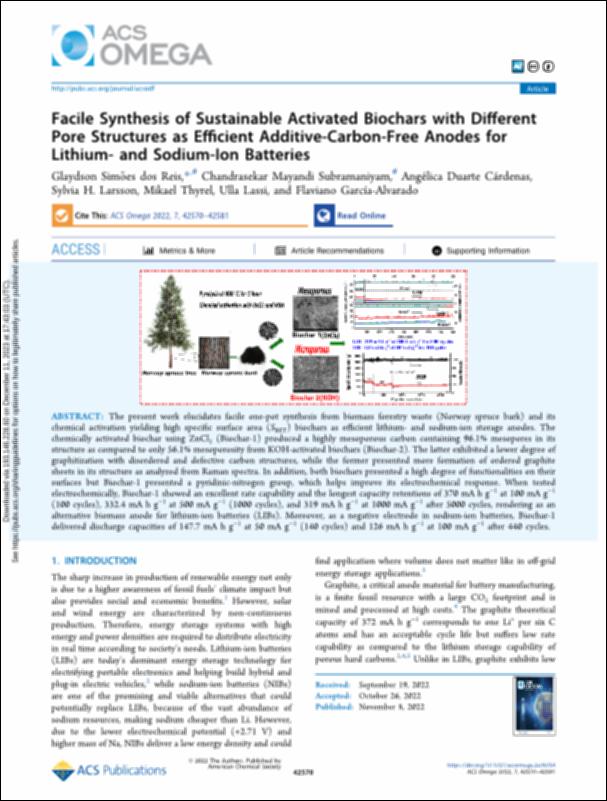Please use this identifier to cite or link to this item:
http://hdl.handle.net/10637/14761Facile Synthesis of Sustainable Activated Biochars with Different Pore Structures as Efficient Additive-Carbon-Free Anodes for Lithium- and Sodium-Ion Batteries
| Title: | Facile Synthesis of Sustainable Activated Biochars with Different Pore Structures as Efficient Additive-Carbon-Free Anodes for Lithium- and Sodium-Ion Batteries |
| Authors : | Simoes dos Reis, Glaydson Mayandi Subramaniyam, Chandrasekar Duarte Cárdenas, Angélica Larsson, Sylvia H. Thyrel, Mikael Lassi, Ulla García Alvarado, Flaviano |
| Keywords: | Carbon; Chemical structure; Electrical properties; Electrodes; Porosity |
| Publisher: | American Chemical Society |
| Citation: | imões Dos Reis G, Larsson S, Thyrel M. Facile Synthesis of Sustainable Activated Biochars with Different Pore Structures as Efficient Additive-Carbon-Free Anodes for Lithium- and Sodium-Ion Batteries. ACS Omega, 7, 46, 42570-42581, 2022. 10.1021/acsomega.2c06054 |
| Abstract: | The present work elucidates facile one-pot synthesis from biomass forestry waste (Norway spruce bark) and its chemical activation yielding high specific surface area (SBET) biochars as efficient lithium- and sodium-ion storage anodes. The chemically activated biochar using ZnCl2 (Biochar-1) produced a highly mesoporous carbon containing 96.1% mesopores in its structure as compared to only 56.1% mesoporosity from KOH-activated biochars (Biochar-2). The latter exhibited a lower degree of graphitization with disordered and defective carbon structures, while the former presented more formation of ordered graphite sheets in its structure as analyzed from Raman spectra. In addition, both biochars presented a high degree of functionalities on their surfaces but Biochar-1 presented a pyridinic-nitrogen group, which helps improve its electrochemical response. When tested electrochemically, Biochar-1 showed an excellent rate capability and the longest capacity retentions of 370 mA h g–1 at 100 mA g–1 (100 cycles), 332.4 mA h g–1 at 500 mA g–1 (1000 cycles), and 319 mA h g–1 at 1000 mA g–1 after 5000 cycles, rendering as an alternative biomass anode for lithium-ion batteries (LIBs). Moreover, as a negative electrode in sodium-ion batteries, Biochar-1 delivered discharge capacities of 147.7 mA h g–1 at 50 mA g–1 (140 cycles) and 126 mA h g–1 at 100 mA g–1 after 440 cycles. |
| URI: | http://hdl.handle.net/10637/14761 |
| Rights : | http://creativecommons.org/licenses/by-nc-nd/4.0/deed.es |
| ISSN: | 2470-1343 |
| Issue Date: | 8-Nov-2022 |
| Center : | Universidad San Pablo-CEU |
| Appears in Collections: | Facultad de Farmacia |
Items in DSpace are protected by copyright, with all rights reserved, unless otherwise indicated.


